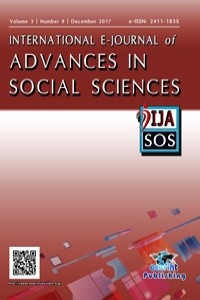Abstract
References
- Croft, W. (2001). Explaining language change. An evolutionary approach. Demirci, K. (2008). Dilbilgiselleşme üzerine bir inceleme. Türk Dünyası Sosyal Bilimler Dergisi, vol. 45. Diessel, H. (2012). Grammaticalization and language acquisition. The Oxford handbook of Grammaticalization. Givon, T. (1971). Historical syntax and synchronic morphology: An archeologist’s field trip. Papers from the Regional Meeting of the Chicago Linguistic Society, vol.7 Heine, B. (2012). The Oxford handbook of Grammaticalization. Heine, B. and Kuteva, T. (2002). Word lexicon of grammaticalization. Hopper, P. J. (1996). Some recent trends in grammaticalization.Annual Review of Anthropology, vol. 25. Hopper, P. J. and Traugott, E. (1993). Grammaticalization. Juldashev, A. A. (1965). Analiticheskie formy glagola v Tjurkskih jazıkah [Analytical verb forms in the Turkic languages]. Kondratjev, V. G.(1992). Osnovnye tendencii v razvitii grammaticheskogo stroja tureckogo jazyka [Major trends in the Turkish language development]. Kurylowicz, J. (1965). The evolution of grammatical categories. Diogenes ( 51). Lehmann, Ch. 1982 (2002). Thoughts on gramaticalization. Meillet, A. (1912). L’évolution des formes grammaticales. Scientia – Rivista di Scienza (12). Pamuk, O. (1999). Öteki renkler. Pamuk, O. (2002). Kar. Pamuk, O. (2008). Masumiyet Müzesi. Quirk, R., Greenbaum, S., Leech, J. and Svartvik, J. (1985). A Comprehensive Grammar of the English Language. Traugott, E. and Heine, B. (1991). Grammaticalization. Van der Auwera, J., Olmen, D. V. and Mon, D. D. (2015). Grammaticalization. Handbook of Cognitive Linguistics. Büyük Türkçe Sözlük. http://www.tdk.gov.tr/index.php?option=com_bts&view=bts. Güncel Türkçe Sözlük. http://www.tdk.gov.tr/index.php?option=com_gts&view=gts. Nişanyan sözlük. http://www.nisanyansozluk.com. English Oxford Living Dictionaries. https://en.oxforddictionaries.com TS Corpus. https://tscorpus.com.
Abstract
The present paper
is concerned with the grammaticalization of the Turkish aspectual verb başlamak. The paper analyses the level
of autonomy of başlamak with Ch.
Lehmann’s parameters of grammaticalization. These parameters are based on three
criteria, i.e. weight, cohesion and variability, which act on syntagmatic and
paradigmatic axes. The weight of a sign viewed paradigmatically is its
integrity or semantic and phonological complexity. Viewed syntagmatically, it
is its structural scope, i.e. the extent of constructions it helps to form. For
başlamak no signs of phonological
attrition (gradual loss of phonological substance) were found. Semantically it
has inceptive meaning and acts both
as main and functional verb with no change of meaning. Başlamak forms constructions with verbal nouns ending in –maya/-meye, which generally belong to
dynamic situation types. The cohesion of a sign on paradigmatic level is
depicted by its paradigmaticity, i.e. the degree to which a sign enters a
paradigm. On syntagmatic level the cohesion of a sign is associated with the
degree to which it depends on or attaches to other signs. Başlamak
is the main means of expressing initial phase in the Turkish language. Verbal
constructions with it are built
according to the schema where başlamak
follows a verbal noun, ending in –maya
/-meye, are easily divided into logical parts and are not phraseologically
related. Paradigmatic variability is the freedom with which the language user
chooses a sign which is concerned with the restrictions on its usage. Başlamak is used with no limitations in
the structures and forms peculiar to the Turkish language. Syntagmatic
variability, in the case of a grammaticalized sign, concerns mainly its
positional mutability with respect to those constituents with which it enters
into construction. Başlamak is
located in the postposition to its complement and syntactically serves link
verbs functions majorly acting as a part of complex predicate. The analysis
shows that development of başlamak
doesn’t show many signs of desemanticization, obligatorification, coalescence
and other processes characteristic to grammaticalization. Being
semantically neutral and syntagmatically and paradigmatically variable it
occupied its slot in expressing initial phase of action in the Turkish
language.
Keywords
aspectual verbs initial phase grammaticalization Ch. Lehmann’s parameters the Turkish language
References
- Croft, W. (2001). Explaining language change. An evolutionary approach. Demirci, K. (2008). Dilbilgiselleşme üzerine bir inceleme. Türk Dünyası Sosyal Bilimler Dergisi, vol. 45. Diessel, H. (2012). Grammaticalization and language acquisition. The Oxford handbook of Grammaticalization. Givon, T. (1971). Historical syntax and synchronic morphology: An archeologist’s field trip. Papers from the Regional Meeting of the Chicago Linguistic Society, vol.7 Heine, B. (2012). The Oxford handbook of Grammaticalization. Heine, B. and Kuteva, T. (2002). Word lexicon of grammaticalization. Hopper, P. J. (1996). Some recent trends in grammaticalization.Annual Review of Anthropology, vol. 25. Hopper, P. J. and Traugott, E. (1993). Grammaticalization. Juldashev, A. A. (1965). Analiticheskie formy glagola v Tjurkskih jazıkah [Analytical verb forms in the Turkic languages]. Kondratjev, V. G.(1992). Osnovnye tendencii v razvitii grammaticheskogo stroja tureckogo jazyka [Major trends in the Turkish language development]. Kurylowicz, J. (1965). The evolution of grammatical categories. Diogenes ( 51). Lehmann, Ch. 1982 (2002). Thoughts on gramaticalization. Meillet, A. (1912). L’évolution des formes grammaticales. Scientia – Rivista di Scienza (12). Pamuk, O. (1999). Öteki renkler. Pamuk, O. (2002). Kar. Pamuk, O. (2008). Masumiyet Müzesi. Quirk, R., Greenbaum, S., Leech, J. and Svartvik, J. (1985). A Comprehensive Grammar of the English Language. Traugott, E. and Heine, B. (1991). Grammaticalization. Van der Auwera, J., Olmen, D. V. and Mon, D. D. (2015). Grammaticalization. Handbook of Cognitive Linguistics. Büyük Türkçe Sözlük. http://www.tdk.gov.tr/index.php?option=com_bts&view=bts. Güncel Türkçe Sözlük. http://www.tdk.gov.tr/index.php?option=com_gts&view=gts. Nişanyan sözlük. http://www.nisanyansozluk.com. English Oxford Living Dictionaries. https://en.oxforddictionaries.com TS Corpus. https://tscorpus.com.
Details
| Journal Section | Research Article |
|---|---|
| Authors | |
| Publication Date | December 27, 2017 |
| Submission Date | September 18, 2017 |
| Published in Issue | Year 2017 Volume: 3 Issue: 9 |
Contact: ijasosjournal@hotmail.com
The IJASOS Journal's site and its metadata are licensed under CC BY
Published and Sponsored by OCERINT International © 2015- 2025

